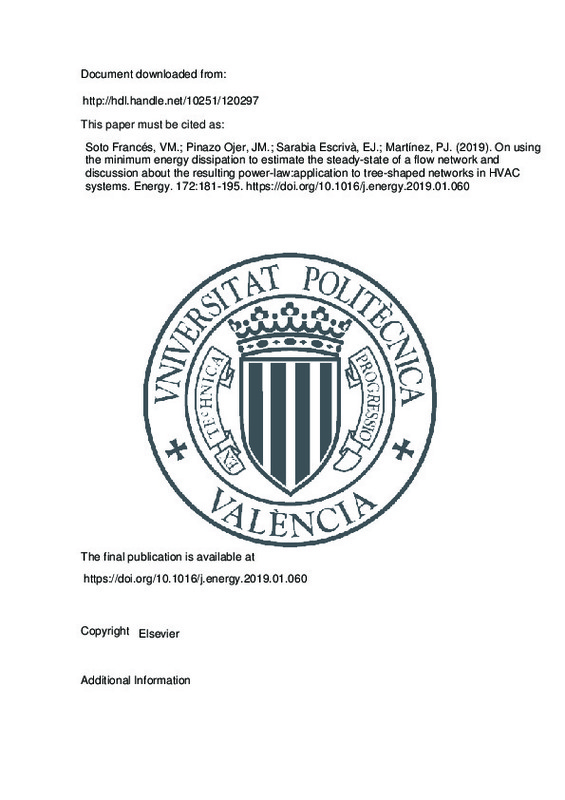JavaScript is disabled for your browser. Some features of this site may not work without it.
Buscar en RiuNet
Listar
Mi cuenta
Estadísticas
Ayuda RiuNet
Admin. UPV
On using the minimum energy dissipation to estimate the steady-state of a flow network and discussion about the resulting power-law:application to tree-shaped networks in HVAC systems
Mostrar el registro sencillo del ítem
Ficheros en el ítem
| dc.contributor.author | Soto Francés, Víctor Manuel
|
es_ES |
| dc.contributor.author | Pinazo Ojer, José Manuel
|
es_ES |
| dc.contributor.author | Sarabia Escrivà, Emilio José
|
es_ES |
| dc.contributor.author | Martínez, Pedro J.
|
es_ES |
| dc.date.accessioned | 2019-05-10T20:31:12Z | |
| dc.date.available | 2019-05-10T20:31:12Z | |
| dc.date.issued | 2019 | es_ES |
| dc.identifier.issn | 0360-5442 | es_ES |
| dc.identifier.uri | http://hdl.handle.net/10251/120297 | |
| dc.description.abstract | [EN] The paper analyses how to compute the steady-state flow distribution through a given network by using the Minimum Entropy Production (MinEP) principle. For isothermal and incompressible flows, this is equivalent to the minimal dissipation of energy. The conditions that make this method equivalent to the conventional one are studied. There must exist a power-law for the energy dissipation (entropy generation) where the exponent must be the same for the whole network. To our knowledge, Niven was the first to get to this result. However he applied MinEP only to parallel pipes and unfortunately discarded it as a general method. The paper shows why it cannot be discarded yet. We discuss the role of the chosen exponent m and its link to the underlying physical phenomena. Moreover it is shown that there is a ¿hidden¿ fixed point value problem that must be studied further. The method introduced in this paper is developed specially for tree-shaped duct-networks which are frequently encountered in HVAC (Heating Ventilation and Air Conditioning) systems. The paper explains briefly what triggered this research; specifically, difficulties related with branched junctions, mainly in return-type networks. | es_ES |
| dc.language | Inglés | es_ES |
| dc.publisher | Elsevier | es_ES |
| dc.relation.ispartof | Energy | es_ES |
| dc.rights | Reconocimiento - No comercial - Sin obra derivada (by-nc-nd) | es_ES |
| dc.subject | MinEP | es_ES |
| dc.subject | Entropy generation | es_ES |
| dc.subject | Steady-state | es_ES |
| dc.subject | Flow network | es_ES |
| dc.subject | HVAC duct network | es_ES |
| dc.subject.classification | MAQUINAS Y MOTORES TERMICOS | es_ES |
| dc.title | On using the minimum energy dissipation to estimate the steady-state of a flow network and discussion about the resulting power-law:application to tree-shaped networks in HVAC systems | es_ES |
| dc.type | Artículo | es_ES |
| dc.identifier.doi | 10.1016/j.energy.2019.01.060 | es_ES |
| dc.rights.accessRights | Abierto | es_ES |
| dc.contributor.affiliation | Universitat Politècnica de València. Departamento de Termodinámica Aplicada - Departament de Termodinàmica Aplicada | es_ES |
| dc.description.bibliographicCitation | Soto Francés, VM.; Pinazo Ojer, JM.; Sarabia Escrivà, EJ.; Martínez, PJ. (2019). On using the minimum energy dissipation to estimate the steady-state of a flow network and discussion about the resulting power-law:application to tree-shaped networks in HVAC systems. Energy. 172:181-195. https://doi.org/10.1016/j.energy.2019.01.060 | es_ES |
| dc.description.accrualMethod | S | es_ES |
| dc.relation.publisherversion | https://doi.org/10.1016/j.energy.2019.01.060 | es_ES |
| dc.description.upvformatpinicio | 181 | es_ES |
| dc.description.upvformatpfin | 195 | es_ES |
| dc.type.version | info:eu-repo/semantics/publishedVersion | es_ES |
| dc.description.volume | 172 | es_ES |
| dc.relation.pasarela | S\376924 | es_ES |







![[Cerrado]](/themes/UPV/images/candado.png)

